What is sketchnoting?
If you’re a teacher on Twitter, chances are you’ve seen at least one sketchnote, if not many. What is a sketchnote?
Sketchnotes are rich visual notes created from a mix of handwriting, drawings, hand-drawn typography, shapes, and visual elements like arrows, boxes, and lines.
The best way to figure out what makes a sketchnote? Go look through a whole lot of them! On Twitter (no account needed) look up #sketchnote to see many different examples & styles across different disciplines. Teachers in particular seem to have taken strongly to this visual note-taking method as a way of sharing ideas and tools.
You don’t have to be a fancy artist to sketchnote. In fact, sometimes simple stick figures make the best illustrations for a sketchnote! Can you draw a stick man? Then you can draw! As Mike Rohde says, sketchnotes are about “ideas, not art“.
To see some examples of the sketchnotes I’ve created, have a look here.
Why should I sketchnote?
Sketchnoting, for me, primarily serves as a way to take notes, but more visually. It helps me remember what I’ve read, heard or seen. It helps me to organize ideas. It’s primary function is as a record, for me! When I think they might also be useful to others – and turn our nice enough – I share them on Twitter so other teachers can learn from them too. I often get teachers asking if it’s OK to print them up as posters for their classrooms or staff rooms – I always say yes of course!
Having trouble building a PLN on Twitter? Create a sketchnote & share it on your Twitter account with #sketchnote. People go crazy for sketchnotes & they get retweeted & shared way more than my usual tweets.
If you’re interested in some of the research that supports an activity like sketchnoting (Dual coding theory, handwriting vs typing notes, etc.) check out Kathy Schrock’s excellent collection of background research here.
What can I sketchnote?
My suggestion to start? Ted Talk videos. Choose your favourite Ted Talk or use this one I often suggest: 10 Ways to Have a Better Conversation. The advantage of sketchnoting videos to start (as opposed to live talks) is that you can rewind & replay as many times as you like to capture the ideas you want in your sketchnote.
There is no end to the things we can sketchnote:
- Videos
- Live keynotes (or recorded talks on YouTube);
- Chapters or articles you’ve read;
I assigned sketchnotes as a reading response/reflection assignment to the students in my EdTech course at the University of Ottawa as a way of checking they’d done their weekly reading. - Movie or Book plots
- Travel logs
- Recipes
- Explainers
(for example, share about a new EdTech tool; like a blog post in one single image) - . . . the list goes on & on – anything you can think of!
When should I sketchnote; live or afterwards?
This is a personal choice. But to start I recommend sketchnoting after the fact or sketching things that you can pause, rewind & look back at. Sketching live during a talk is a whole other ball game, adding the stress of time constraint into the mix. But fun – so give it a shot when you’re ready!
What do I need to get started?
- Paper
- Writing implement; pen, marker or pencil – you choose
People often think they need an iPad and fancy stylus to make a decent sketchnote. And while many of the sketchnotes we see accompanying articles on edu-websites are made on a tablet, you absolutely don’t need one! Just grab your favourite writing implement and an 8.5 x 11 sheet of printer paper to get started. These days, my own analog toolkit is fine-tipped & regular-tipped permanent black markers and a set of crayola markers to colour, highlight & accent with. Lately I’ve been drawing in a blank paged notebook that’s maybe 6″ x 9″?
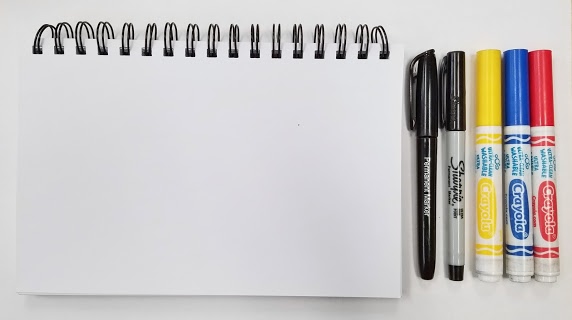
When I do work digitally I use my (now very old & cracked) iPad and a ~20$ disc-tipped stylus I bought off Amazon. On my iPad I use the Paper by FiftyThree app. For smaller drawings on my Android phone I use the Bamboo Paper app.
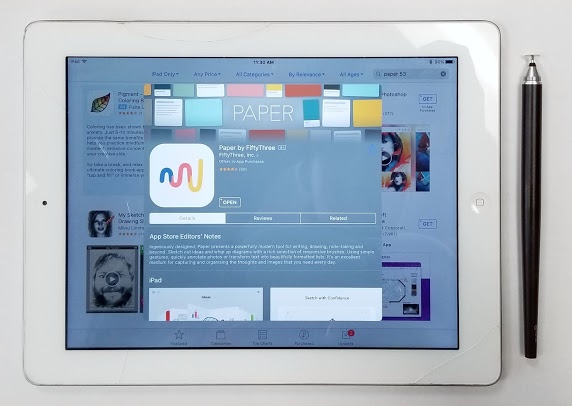
How do I sketchnote?
Decide on a layout: There are many different layouts you can try such as popcorn, radial, columns, paths, etc. But as an easy starter try this one:
Create a title: In big writing either at the top of the page or smack in the middle, write the title of the video, book or whatever it is you’re sketchnoting. If it’s a talk given by a person, it helps to write their name & their twitter handle too.
Now as you listen or read, write down the biggest, most important ideas and/or quotes. Try to use as few words as possible (I’m still working on that skill). Leave some room nearby for a drawing or two.
Either as you go, or afterward, add some drawings next to each idea or quote. Pick the keyword from that text & sketch it. Stuck for ideas? Search words on the Noun Project to get ideas for simple icons that are easy to draw. If you still insist you can’t possibly draw, then here’s a little something for you:
Add colour by using highlighters or markers. Either by drawing over top of black text or by colouring in your drawings, or separating ideas using coloured boxes, etc. You can use many colours, or stick to just one!
Use shapes as containers to separate and emphasize ideas.
Use lines to connect & divide ideas.
If you think you might share your work online, put your name on it somewhere (& your Twitter handle if you have one).
Check out this great sketchnote summary of the above info by Shauna Burnie:
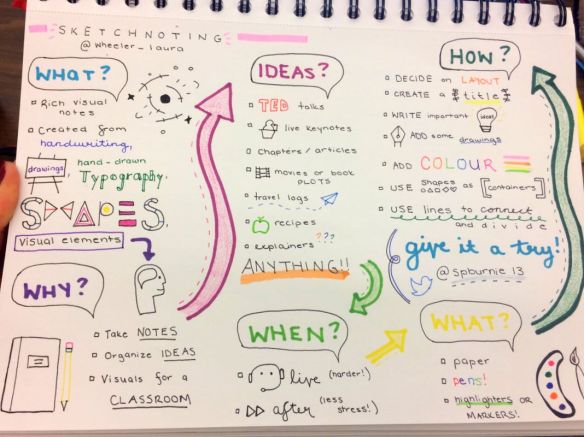
Source: https://imperfectmasterpiece.weebly.com/blog/making-media-4-sketchnoting
Where can I share my sketchnotes?
I really encourage you, no matter how bad you think your sketchnotes are, to share them on Twitter. Or with colleagues. Or show them to a friend at the very least. Take an image of your paper sketchnotes using your cell phone and post them to Twitter with the hashtag #sketchnote!
Who can I follow to learn more?
Sylvia Duckworth gave the first sketchnoting workshop I ever attended. If you’ve seen sketchnotes on edu-blog articles, they were likely hers. She’s a force!
Marie-Andrée Ouimet gave the 2nd sketchnoting workshop I attended (with Joel Charlebois) and even let me follow her back to the final keynote for the conference to watch how she sketchnotes live on the spot. En plus, elle est animatrice d’un podcast – La Folie du Sketchnote – sur lequel elle parle avec des enseignants de toutes sortes qui sont en train d’intégrer le sketchnote soit dans leur salle de classe avec leurs élèves ou pour eux même.
Mike Rohde as the author of the seminal Sketchnote Handbook is a good follow. I like following him because he shares a lot of news and ideas on sketchnoting beyond the edu-sphere.
Wendi Pillars is the author of a great book that explores ways teachers can get their students sketchnoting in the classroom; called Visual Note-Taking for Educators.
Kathy Schrock has a great page chock-o-block full of resources related to sketchnoting worth checking out.
I hope you’ll give sketchnoting a try!
I hope you’ll come back here & share your sketchnote in the comments below.
And know that it’s normal to be frustrated by your first attempts not turning out quite as spectacular as you’d like them to.
My first try:
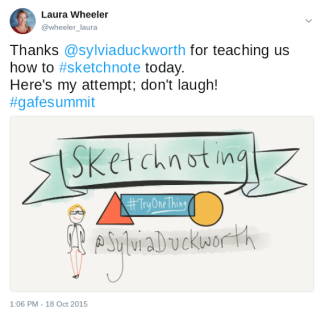
. . . and now:
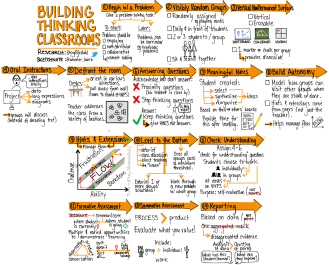
– Laura Wheeler (Teacher @ Ridgemont High School, OCDSB; Ottawa, ON)

Pingback: 3 Act Math #Sketchnote | Wheeler's thoughts on teaching
Pingback: Making Media #4 – Taking a (Sketch)Note from the Best – An Imperfect Masterpiece
Pingback: Screencasting Descriptive Feedback | Wheeler's thoughts on teaching
Pingback: A Trip Around The “Cohort 2018” OJCS Blogosphere – A Floor, But Not a Ceiling
Pingback: #OAME2019 roundup; #sketchnote | Wheeler's thoughts on teaching
Pingback: feeling sketchy? – the chrysalis chronicles
Thank you. It helps me a lot
That’s great – thanks for reading 🙂
Thank you for this learning
Very inspiring.
Pingback: Corey Leigh Latislaw – Podcast S11 E07 [FREE] – Programming Blog